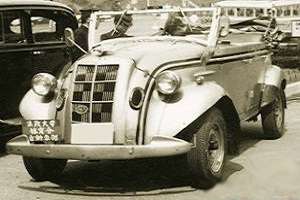Japanese giant Toyota had an unsteady introduction to the car world. The company specialized in making textile looms until 1935, when a windfall on the sale of some patents persuaded Kiichiro Toyoda, son of the founder, to consider entering the car business.

Toyota AA 1937
- YEAR REVEALED 1937
- PLACE OF ORIGIN Koromo City, Japan
- HISTORICAL STATUS production car
- ENGINE six-cylinder, 207ci (3,389cc)
- MAXIMUM POWER 62bhp
- LAYOUT front-mounted engine driving the rear wheels
- BODYWORK four-door five-seater sedan
- TOP SPEED unknown
- NUMBER BUILT 1,404
It was no surprise that the three prototypes he built in May 1935 bore an uncanny resemblance to the Chrysler Airflow-the Toyoda Automatic Loom Works had bought one to take apart, and closely modeled the A-1 on it. They used Toyoda’s newly designed Type A six-cylinder engine in a ladder-type chassis, closely copied from Ford. Yet, unusually for the time, it had pressed-steel disc wheels and a curved, one-piece windshield. Toyoda suspended its fledgling car project to concentrate on the G1 truck, considered a more profitable venture.
In 1937, however, the car was finally announced for sale under the name Toyota AA. Why the change? In July 1937, Kiichiro held a competition to find a new logo for the firm’s vehicle-making venture. The winner, from over 20,000 entries, suggested a harmonious shape in which the Japanese characters suggested speed but, because it used only eight brushstrokes, it was also deemed a symbol of burgeoning prosperity. It was made to align phonetically with the company name by changing the word from “Toyoda” to “Toyota”; Kiichiro also liked the distance it put between the car and its family business origins.